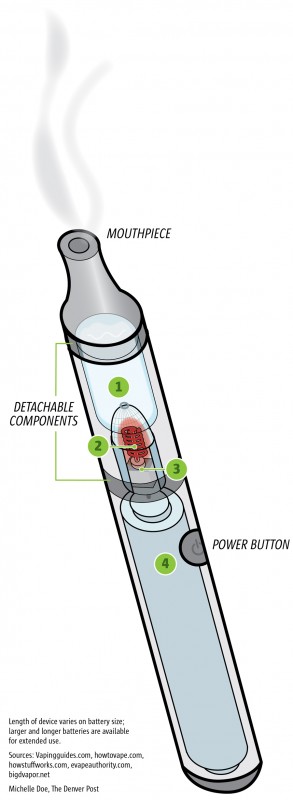What is a vape pen, exactly, and how does it work? Here’s essential info (and cool trivia, too):
When cannabis is heated to temperatures between 300-450 degrees Fahrenheit, cannabinoids like psychoactive THC (and myriad other compounds) take flight, volatilizing into tiny airborne droplets that form an aerosol we call smoke or “vapor.” Vape pens accomplish this basic marijuana math using a battery-powered heating element to cook cannabis oil that is typically mixed with a substance like propylene glycol to decrease viscosity.
The first modern vape pen — crafted by Chinese pharmacist and inventor Hon Lik, whose patents are now owned and litigation-backed by Imperial Tobacco — actually vaporizes liquid into a gaseous state using high-frequency ultrasonic vibration. If that seems hard to wrap your head around, it totally is, which is one reason other vape pens just use a simple heater to approximate that patented vaporization idea.
A closer look at vape pen components

1. The tank
The cannabis oil holder is usually called a tank if refillable, or cartridge if it’s intended for single-use. It’s also typically combined with the atomizer as a single unit. Tanks are usually polycarbonate plastic, but glass and stainless steel tanks can also be found.
2. The atomizer
The little heater in a vape pen is called an atomizer. Fancier versions are called cartomizers, clearomizers or other new jargon, but they are still atomizers at heart — that pint-size heating element converts liquid to tiny airborne droplets. Atomizing is what we should really call vaping, but that’s a lost cause for sure.
If you dab a bit of oil on the heating element, that product will likely be labeled an atomizer. Surround the atomizer with polyfill material to keep it saturated with oil from a separate tank and it’s a cartomizer. Drip the oil from a separate tank onto the atomizer using a silica wick and it’s a clearomizer. The wick can be swapped for cotton, steel mesh, or other “premium” materials.
3. The sensors and software
Some vape pens automatically turn on when the user inhales through it, while others use a push button to toggle the heating element. Both of these methods require sensors to determine when the user is inhaling or button-pushing. Embedded software controls the various pen parts.
4. The battery
Vape pen batteries must provide enough current to power a tiny heater that reaches 400 degrees in mere seconds. So, just like your cell phones and other power-hungry devices, vape pens use rechargeable lithium ion batteries, which have high energy density. They also have a very small chance of exploding if improperly charged.
With these components working together — and some cannabis oil to fill it with — the vape pen produces a cannabinoid-rich puff of smoke.
Why O.penVAPE prefers supercritical CO2 extraction for their vape pens





